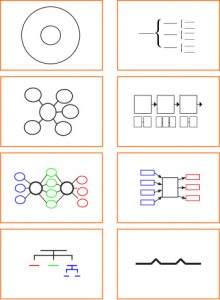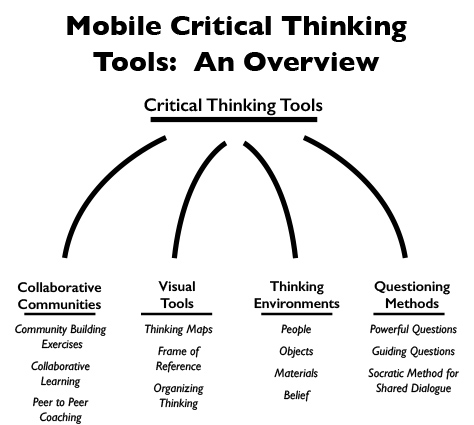The four pillars of critical thinking are models of practical methods that are the core of developing critical thinking skills.
Download Critical Thinking Guide
Collaborative Communities are three supporting methods of collaborative tools for individual and collaborative success. These include: community building exercises and models, collaborative learning methods and peer-to-peer coaching.
Questioning Methods are used to engage students in curiosity, exploration, discovery and discussions. This includes effective methods for developing questioning skills leading to inquiry based shared inquiry.
Open Source Visual Mapping is for organizing and understanding thinking individually and collaboratively. The maps support recognizing patterns of thinking along with the frame of reference to understand different perspectives.
Thinking Environments is an awareness, understanding and a process focused on the design, interface and impact of the environment including a person’s use of space, materials, and objects.
Collaborative Communities
 A collaborative community learns with and from one another. Like any experience, intentionality of actions and practice is imperative with the methods of collaboration. The collaborative process include three key areas: community building exercises, peer to peer coaching and collaborative learning methods.
A collaborative community learns with and from one another. Like any experience, intentionality of actions and practice is imperative with the methods of collaboration. The collaborative process include three key areas: community building exercises, peer to peer coaching and collaborative learning methods.
Community Building Exercises
Building community exercises involves developing the whole community together for understanding one another, learning how to collaborate collectively, developing listening for learning, and other methods for the whole school community collectively learning with one another.
Peer to Peer Coaching
Peer to Peer Coaching involves teachers creating their own professional coaching community. It includes regularly observing each other throughout the whole school with a focused protocol to support seeing each other’s professional skills. The goal is learning professionally from one another in quest of the finest craft and pedagogy for student outcomes.
Collaborative Learning Methods
Collaborative learning builds relationships among students (and teachers with teachers) that requires positive inter-dependence (a sense of sink or swim together), individual accountability (each of us has to contribute and learn), interpersonal skills (communication, trust, leadership, decision making, and conflict resolution), face-to-face promotive interaction, and processing (reflecting on how well the team is functioning and how to function even better).
Questioning Methods
 The use of questions are used in many fields including the sciences, journalism and many more. They are a gateway of curiosity with learning, and an insightful and effective way of understanding. Questioning is a key means by which teachers and students find out what they already know, identify gaps in knowledge and understanding, and scaffold the development of their understanding to enable them to close the gap between what they currently know and the learning goals.
The use of questions are used in many fields including the sciences, journalism and many more. They are a gateway of curiosity with learning, and an insightful and effective way of understanding. Questioning is a key means by which teachers and students find out what they already know, identify gaps in knowledge and understanding, and scaffold the development of their understanding to enable them to close the gap between what they currently know and the learning goals.
We ask questions regularly. There are several types of questions:
- factual
- evaluative
- interpretive
Statements and Questions
Statements are ‘answers’ that signal a stop in thinking with a final answer. Questions are a driving force in the process of thinking. One asks questions to stimulate thinking. The art of questions like any skill takes practice of the finer points to achieve mastery. We will focus on bringing questioning into the classrooms critical thinking by scaffolding supportive strategies:
Powerful Questions
Collaborative Questions
Socratic Method for Shared Dialogue with Classroom Discussions
Visual Mapping
 Visual tools are a means of graphically and visually representing ideas, conceptual relationships and progression paths. They range from the simple spider diagram, flow chart or time line – to more sophisticated models of concept mapping which can be used to explore complex relationships and perceptions. Thinking Maps is a language that provide students with choices of eight visual maps that represent how humans think cognitively (brainstorming; cause/effect; sequence; compare/contrast; categorization; relationships…). Each map can be further developed with a frame of reference. Thinking Maps are a critical thinking tool that is most effectively used when students have the ownership of choosing the Thinking Map(s) that best represents their cognitive choice. Thinking Maps organize thinking for understanding, writing, presenting, and understanding each other’s thinking. The steps of implementation in a classroom include:
Visual tools are a means of graphically and visually representing ideas, conceptual relationships and progression paths. They range from the simple spider diagram, flow chart or time line – to more sophisticated models of concept mapping which can be used to explore complex relationships and perceptions. Thinking Maps is a language that provide students with choices of eight visual maps that represent how humans think cognitively (brainstorming; cause/effect; sequence; compare/contrast; categorization; relationships…). Each map can be further developed with a frame of reference. Thinking Maps are a critical thinking tool that is most effectively used when students have the ownership of choosing the Thinking Map(s) that best represents their cognitive choice. Thinking Maps organize thinking for understanding, writing, presenting, and understanding each other’s thinking. The steps of implementation in a classroom include:
- Introducing all eight Thinking Maps to learn the tool using pictures, words and other representations for all grade levels.
- Introducing the Frame of Reference for Thinking Maps and other visual tools.
- Learning hand symbols for each of the Thinking Maps.
- Students choosing the Thinking Map that best represents how they are organizing their thinking (student centered ownership).
- Integrating Thinking Maps across all subjects and content.
Critical Thinking Environments
 Critical Thinking Environments, is an awareness, understanding and a process focusing upon the design, interface and impact with the environment of the physical learning space. An awareness with intentionality. The environment is The Third Teacher where we focus on designing the physical space with the Frame of the Student as a root understanding. The in the eyes of the student respects and understands the children’s frame of reference in regards to how children see, sense, use and interface within the environment, and how the teacher is intentional with their choices, decisions and actions in respect to student engagement and successes with learning. The key components of focus for a successful teaching environment include:
Critical Thinking Environments, is an awareness, understanding and a process focusing upon the design, interface and impact with the environment of the physical learning space. An awareness with intentionality. The environment is The Third Teacher where we focus on designing the physical space with the Frame of the Student as a root understanding. The in the eyes of the student respects and understands the children’s frame of reference in regards to how children see, sense, use and interface within the environment, and how the teacher is intentional with their choices, decisions and actions in respect to student engagement and successes with learning. The key components of focus for a successful teaching environment include:
- Beliefs with a classroom of equity that focuses on mindfulness of belonging for all students and adults in a learning environment.
- People including proximity of the teacher with students and how we choreograph the flow.
- Objects in the classroom including furniture, lighting and all objects that influence in regards to their design and use.
- Materials used including choices and use of natural and recycled things.
The teacher’s decisions with intentionality impact the classroom and school’s environment. They are crucial to the quality outcomes of the children and youth’s learning experiences and how they model with the children, and become a model to how students learn.

